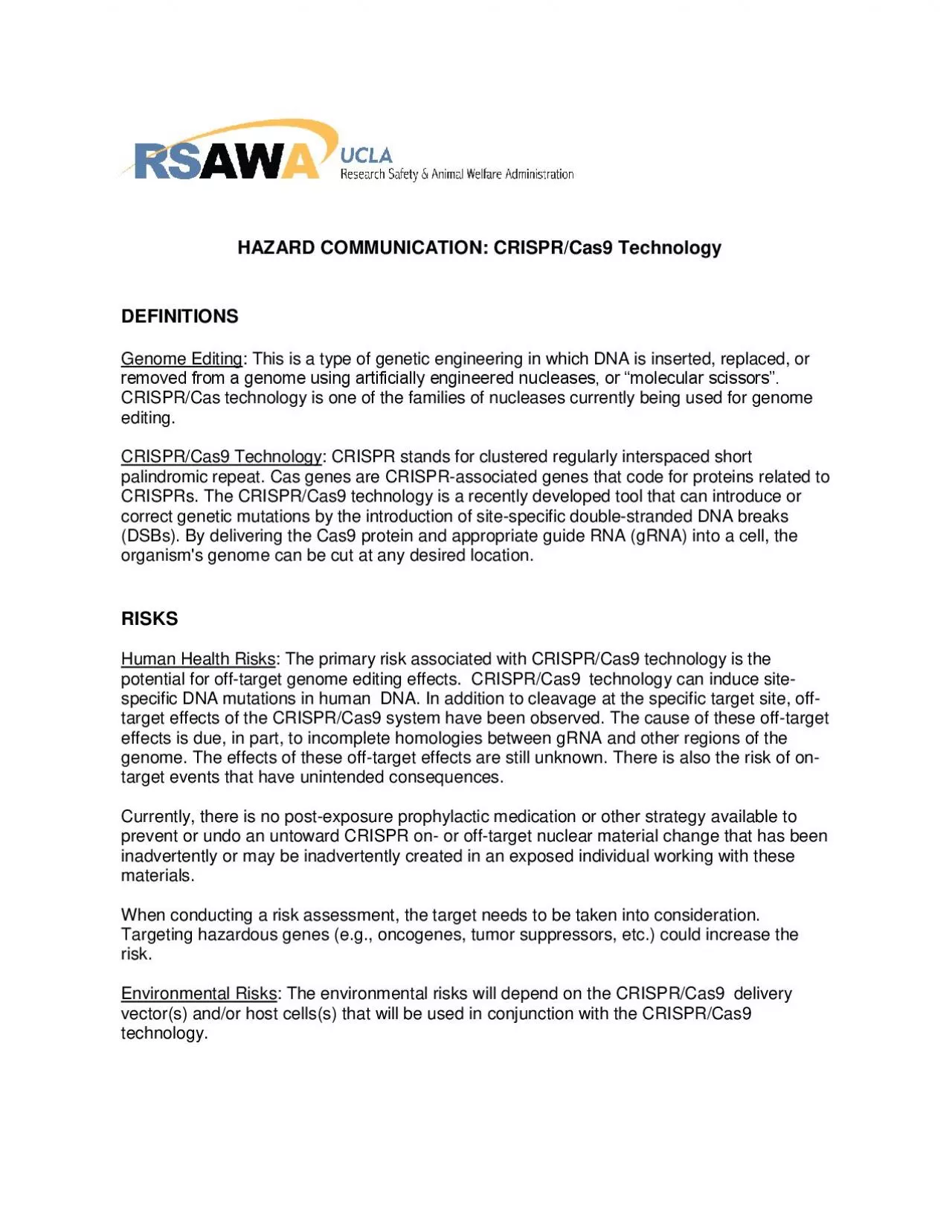

DEFINITIONS Genome Editing This is a type of genetic engineering in which DNA is inserted replaced or removed from a genome using artificially engineered nucleases or molecular scissors ID: 941740
Download Pdf The PPT/PDF document "HAZARD COMMUNICATION CRISPRCas9 Technolo..." is the property of its rightful owner. Permission is granted to download and print the materials on this web site for personal, non-commercial use only, and to display it on your personal computer provided you do not modify the materials and that you retain all copyright notices contained in the materials. By downloading content from our website, you accept the terms of this agreement.
HAZARD COMMUNICATION: CRISPR/Cas9 Technology DEFINITIONS Genome Editing : This is a type of genetic engineering in which DNA is inserted, replaced, or removed from a genome using artificially engineered nucleases, or “molecular scissors”. CRISPR/Cas technology is one of the families of nucleases currently being used for genome editing. CRISPR/Cas9 Technology : CRISPR stands for clustered regularly interspaced short palindromic repeat. Cas genes are CRISPR - associated genes that code for proteins related to CRISPRs. The CRISPR/Cas9 technology is a recently developed tool that can introduce or correct genetic mutations by the introduction of site - specific double - stran ded DNA breaks (DSBs) . By delivering the Cas9 pr otein and appropriate guide RNA (gRNA) into a cell, the organism's genome can be cut at any desired location. RISKS Human Health Risks : The primary risk associated with CRISPR/Cas9 technology is the p otential for off - target genome editing effects . CRISPR / C a s9 t e chno l o g y can induce site - specific DNA mutations in hu m an D NA . I n addition to cleavage at the specific target site, off - target effects of the CRISPR/Cas9 system have been observed. The cause of these off - target effects is due , in part , to i ncomplete homologies between gRNA and other regions of the genome . The effects of these off -
target effects are still unknown. There is also the risk of on - target events that have unintended consequences. C urrently , there is no p ost - exposure prophylactic medication or other strategy available to prevent or un do an untoward CRISPR on - or off - target nuclear material change that has been inadvertently or may be inadvertently created in an exposed individual working with these materials. When conducting a risk assessment, the target needs to be taken into consideration. Targeting hazardous ge nes (e.g., oncogenes, tumor suppressors, etc.) could increase the risk. Environmental Risks : The environmental risks will depend on the CRISPR / C a s9 delivery vector(s) and/or host cells (s) that will be used in conjunction with the CRISPR/Cas9 technology . PRECAUTIONS Specific practices and precautions will depend on the vector(s) and/or host cells (s) that will be used in conjunction with the CRISPR/Cas9 technology. Therefore, a ll personnel working with CRISPR/Cas9 must review and fo ll ow all IBC - approved S O Ps . REFERENCE S Baltimore D, et al. A prudent path forward for genomic engineering and germline gene modification. Science. 2015 Apr 3;348(6230):36 - 8. Gantz VM, Bier E. The mutagenic chain reaction: A method for converting heterozygous to homozygous mutations. Science. 2015 Apr 24;348(6233):442 - 4